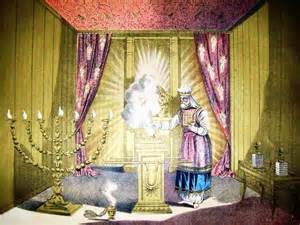“Metzora” or more precisely “Ha Metzora” means “The Leper,” and the portion concerns primarily how a leper gets pronounced clean by the priests, how he demonstrates he has been cleansed from the disease. The previous Torah portion (Tazria) concerned states of impurity and isolation for women who have just given birth and lepers. This portion deals with how to get the lepers clean again. It then takes an interesting turn to discuss what happens when a whole house becomes unclean before ending with other purity rules for men and women.
Tazria means “to bring seed, give birth” It begins with the “niddah” rules, or how a woman is unclean for a certain period after giving birth. The rest of the portion then deals with how lepers are to be isolated and pronounced
clean by the priests before being allowed to rejoin Israel.
Shemini means “on the 8th day” deals with the end of the priests’ consecration period. After this, they can then make expiation for all of Israel. Unfortunately however, two of Aaron’s sons pay the ultimate price for not ministering properly to the people. The portion then ends with the “kosher list” of what can and cannot be eaten, a perfect segue into our Renewed Covenant reading which also discusses kosher food.
Tzav means “command” as in commanding the sons of Aaron. It is another form of the same root we saw in an earlier parsha “tetzaveh” or “you will command/charge”. This time the focus of the portion is on the priestly responsibilities in preparing sacrifices.
“Vayikra” means “and he called” and seems focused on the details about the various offerings and sacrifices that are needed for and by the priests of Aaron. I say “seems focused” because there are a lot of deep spiritual realities laying beneath the surface when we delve into the meanings of these rituals.
“Pekudei” means “these are the records/expenses” and the portion opens with giving the pricing values for the materials that will be used in the Tabernacle. Many exacting physical (and spiritual) details are given for all the wondrous objects and the Tabernacle. But after all these long lists (from this portion and the previous ones) we finally get to the “payoff” in lovely chapter 40. It is in chapter 40, the last of Exodus—that time
begins again as the priests begin their official service for Israel.
“Vayakhel” means “and he assembled.” The verb is derived from KAHAL, Hebrew for “assembly, congregation.” After a brief sermon on the importance of Shabbat, Moshe then gets the Israelites to work on the manifold details of building the Tabernacle and related furniture and objects.
Ki-Tissa means “when you take,” referring to what Israel is to do when it takes a census of all the people. Most censuses in the ancient world are used for the purposes of taxation. This census is no different, except the “tax” is not for an emperor, but for YHWH’s Tabernacle. This “innocent” start though is misleading as it will then progress from those details to the construction of the Ark of the Covenant, only to culminate in disaster when Israel worships the golden calf. In a sense it parallels the pattern we saw with Yitro, except instead of preparation of infrastructure leading to enlightenment it leads to despair and grief. Fortunately though the portion does also end on a hopeful note.
“Tetzaveh” means “you will charge/command,” which opens with requirements for worship that are so important that failure to comply is simply not an option. If these needs are not met, nothing good will ever come about from that nation of Israel. We then get a lot of details about the designs of the priestly garments (ch. 28) and how the priests themselves are to be consecrated (ch. 29). The remaining 10 lines in ch. 30 concern instructions for building the altar.
Terumah means “the contributions” concerns a list of the offerings Israel gives to help build the Tabernacle in the wilderness as well as detailed instructions for building the Arkof the Covenant and other “divine furniture.” Keep Reeding
“The Judgments” concerns a list of rules and regulations that Abba YHWH is giving to
Israel. They involve practical examples from the root commands given at Sinai.
However, there is much more going on here than a mere laundry list of obligations.
Sandwiched between these rules are some of the most powerful insights that Abba
YHWH has ever imparted to man. It’s as if we have to wade through the rules to get to
the reward of these insights. Hey, that sounds a lot like life too!
It’s the behind the scenes story behind one of the most important events in biblical history. The world knows about how Father YHWH gave to Moshe the Ten Commandments, but less well-known is that without the wise counsel of his father-in-law Jethro we would never even get to the this event! Explore the intimate discussion that leads to the most famous Torah utterance of them all!











